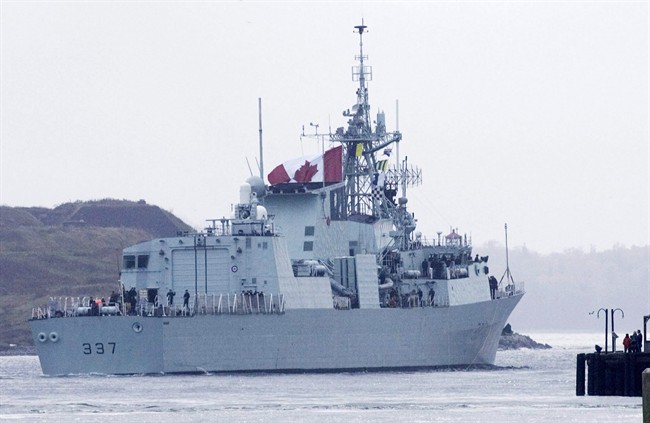With a couple of days of rough weather and a little seasickness along the way, the Canadian warship HMCS Fredericton and its crew have joined their allies in Turkish waters to participate in NATO measures in Central and Eastern Europe.

There, according to its commanding officer, the Canadian frigate and its crew of 260 will spend the next months patrolling, communicating with and sometimes visiting other ships, and making NATO’s presence known in the area.
The ship sailed from Halifax January 5 as part of Operation REASSURANCE, the Canadian Armed Forces’ contribution to a NATO effort to counter Russian-backed unrest in Ukraine.
WATCH: HMCS Fredericton departs for Mediterranean Sea to join Operation Reassurance

The vessel will also conduct counter-terrorism patrols and generally be ready to take on any mission required, “from search and rescue to anti-air or anti-submarine warfare and everything in between,” Cmdr. Trevor MacLean said in an interview.
Since joining a German-led NATO task group, the focus has been on ‘integration training,’ or making sure the vessels from different countries will communicate well in the event of a threat.
“Our ability to operate with each other at sea is something we really focus on whenever we get together,” MacLean said.
MacLean said the toughest part of training for the deployment was mentally preparing to spend six to seven months at sea in an enclosed space with 260 other people.
“But once you get away and get into a routine at sea and get into the day-to-day of doing something we’re all proud of doing, it gets a little easier every day,” he said.
The routine for crew members at sea consists of 12-hour shifts, with the rest of the time dedicated to meals, administrative work, fitness and sleep. A civilian from the personal support program is on board to organize fitness classes and activities that stave off boredom.
Every few weeks, the NATO ships stop in different ports, which means the crew can go ashore, and sometimes can get together with crews from different ships for sporting events and social activities.
“After a few weeks at sea we can go a little stir crazy but you always have that next port of call to look forward to,” MacLean said.
READ MORE: HMCS Fredericton departs for Mediterranean Sea to join Operation Reassurance
Last June, the Fredericton and its previous crew made headlines when the vessel was shadowed by two Russian frigates during a visit by then-Prime Minister Stephen Harper and his wife, Laureen.
This time, MacLean says that although the crew has seen some Russian ships at sea, there have been only “standard, cordial encounters.”
Nevertheless, he describes the eastern Mediterranean as a “busy spot.”
“This part of the world is at a critical point in its history with the events in Syria, with the Russia’s involvement and of course the human side of that are the refugees and migrants blowing across the land and using the sea as well,” MacLean said. “So it’s a very interesting place in the world right now.”
He said the toughest part of deployment is the separation from friends and family, although technology has made it much easier to stay in touch by internet and phone.
The best part of being at sea, according to MacLean, is representing Canada on the global stage.
“You forge yourselves into a team over a few months and then you take that team to the far side of the world underneath the Canadians flag, and you get to show on a world stage what 260 well-trained, motivated, dedicated Canadians can do,” he said. “It’s amazing, it’s an amazing experience.”



Comments